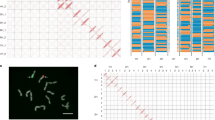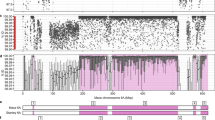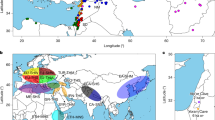Abstract
Doubled haploid systems offer the quickest method of advancing heterozygous breeding lines to homozygosity. Currently the Hordeum bulbosum technique is the most efficient method of haploid production in barley. However, at present, the efficiency of this system is reduced by the suggested need for a multiplication phase following colchicine treatment of haploid plants prior to agronomic assessment. In this paper it is demonstrated that the rankings of the H1 (the first selfed generation after colchicine treatment) and H2 (second generation) generations remain unaltered. Furthermore it is shown that the correspondence between parents and progeny or H1 and H2 is determined by the relative magnitude of the additive genetic variation to the total phenotypic variation. The production of variation following a tissue culture phase (somaclonal variation) has been reported in barley. In this study the H. bulbosum doubled haploid system did not show any evidence of generating such variation.
Similar content being viewed by others
Article PDF
References
Huang, B. Dunwell, J M. Powell, W. Hayter, A M, and Wood, W. 1984. The relative efficiency of microspore culture and chromosome elimination as methods of haploid production in Hordeum vulgare L. Z. Planzenzucht, 92, 22–29.
Jinks, J L, and Pooni, H S. 1976. Predicting the properties of recombinant inbred lines derived by single seed descent. Heredity, 36, 253–266.
Pooni, H S. Jinks, J L, and Pooni, G S. 1980. A general method for the detection and estimation of additive dominance and epistatic variation for metrical traits IV. Triple test cross analysis for normal families and their selfs. Heredity, 44, 172–192.
Powell, W. Hayter, A M. Wood, W. Dunwell, J M, and Huang, B. 1984. Variation in the agronomic characters of microspore-derived plants of Hordeum vulgare cv Sabarlis, Heredity, 52, 17–23.
Reinbergs, E. Park, S J, and Song, L S P. 1976. Early identification of superior barley crosses by the doubled haploid technique. Z. Pflanzenzucht, 76, 215–224.
Snape, J W, and Simpson, E. 1981. The use of doubled haploid lines for genetical analysis in barley. In Proceedings of the Fourth Barley Genetics Symposium, Edinburgh, 1981. Edinburgh Univ. Press. 704–709.
Tapsell, C R. 1984. Cross prediction studies on spring barley. Ph.D. Thesis, Univ. of Birmingham.
Thomson, W J, and Matthews, S. 1981. The effect of day-length and sowing date on ear development in barley cultivars. In Proceedings of the Fourth Barley Genetics Symposium, Edinburgh, 1981. Edinburgh Univ. Press. 518–526.
Walsh, E J. Reinbergs, E, and Kasha, K J. 1973. The importance of seed source in preliminary evaluations of doubled haploids in barley. Canad J Plant Sci, 53, 257–260.
Author information
Authors and Affiliations
Rights and permissions
About this article
Cite this article
Powell, W., Caligari, P., Jinks, J. et al. The use of doubled haploids in barley breeding. I. Comparison of H1 and H2 generations. Heredity 54, 261–266 (1985). https://doi.org/10.1038/hdy.1985.35
Received:
Issue date:
DOI: https://doi.org/10.1038/hdy.1985.35
This article is cited by
-
Comparisons between doubled haploid lines produced by anther culture, the Hordeum bulbosum-method and lines produced by single seed descent in barley crosses
Euphytica (1992)
-
Field performance of lines derived from haploid and diploid tissues of Hordeum vulgare
Theoretical and Applied Genetics (1986)
-
Genetical investigations into β-glucan content in barley
Theoretical and Applied Genetics (1985)



